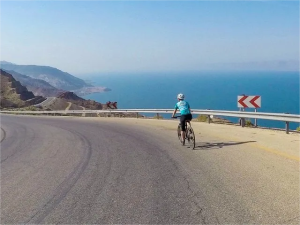The Ultimate Guide to Sustainable Travel – 10 Tips to Travel Responsibly
- by Mohamed Adam

A Step-by-Step Beginner’s Guide to a Sustainable Travel
1. Choose Your Location Wisely
When you choose your destination to travel, it helps if you select one of the most sustainable nations meeting internationally established environmental targets. According to the Environmental Performance Index, the eco-credentials of the top five are Finland, Iceland, Sweden, Denmark and Slovenia.
It is said that environmentally-friendly destinations tend to provide a better quality of travel experience. So, if the world is your oyster and you can’t choose where to go, put these eco-friendly nations top of your list.
2. Consider Your Mode of Transport for sustainable travel
It is also important to select the most conservative method of traveling. For example, if your destination is reachable by bus or train, opt for these land-modes of transport instead of air as these produce fewer carbon emissions.
Referring to these statistics, a return trip from London to Paris by plane takes 3.5 hours and produces 244 kg/CO2 by plane each way. If you opt for the Eurostar, it takes 2.75 hours and produces 22 kg/CO2 which is a whopping 91% less. Not only is it so much better for the environment but it’s even quicker and probably even cheaper too!
If you don’t have a choice and you really need to travel by air, select the most eco-friendly airlines. Booking non-stop flights also saves more fuel since taking off and landing consume the most amount of energy during your flight. Using public transport once you get to your destination also reduces your total travel carbon dioxide emissions compared to renting a car.
3. If You Can Pack Light, Just Take Hand Luggage
If you’ve gotta fly, then try to only take hand luggage. The more stuff you pack, the more fuel the plane has to use transporting it and therefore the more carbon emissions created.
Not only will this mean the plane will produce less energy but it will help you to save energy too! (As well as the plane as you won’t have to lug a bag around!) Plus it will probably be cheaper too as you won’t have to pay for hold luggage.
4. Sustainable travel -Take Some Reusable Items With You
I know that I’ve just said pack as few things as possible – but make sure you save pack a few essential reusable items. For example, this reusable bamboo utensil set includes a reusable bamboo knife, fork, spoon, chopsticks and straw – all in a slim travel carry case, so you’ll have all the utensils you need to eat without using any plastic cutlery. You can even take it in hand luggage and use on the plane to prevent you from having to use the disposable plastic knife and fork they often give out!
Other handy reusable items that I’d recommend are:
- -Reusable water bottles so you can avoid buying plastic bottled water (make sure you take water purifying tablets or a water filter too so you can clean tap water). -You can get a collapsible reusable water bottle so you don’t need to worry about taking up too much space in your bag!
- -A reusable tote bag for shopping in any local markets
- -Reusable cotton pads rather than make-up wipes, we like Face Halo.
5. Buy Local
If you’re shopping for food, go to the local markets and buy the local food. Or if you’re eating out, choose the restaurants that buy local. Local foods often taste better as they’re more authentic to the area, and they won’t have travelled as far to reach you. Plus, this should mean they’ll probably be cheaper too – so it’s a win win!
6. Conserve Water and Reduce Energy Usage When Traveling
Be careful about your water consumption. Skip the long showers, and don’t leave the tap running while you brush your teeth. Clean water is precious everywhere, but in many places, it’s far more scarce than it is at home. Saving the valuable resource of water embraces ecotourism.
Turn the AC down – or even off. When you’re on a holiday and not paying the bills like you do at home, it’s easy to go into holiday mode with electricity. If you’re going out, turn it off! There’s no need to leave it on full blast all day!
7. hHelp sustainable travel -Wash Your Towels & Sheets Consciously
Many hotels change the towels and bed sheets daily but this really isn’t necessary. Do you wash your sheets and towels every single day at home? It uses up a lot energy to wash each set, so tell your hotel you don’t need your items washed every day.
8. Find Ways to Reduce Food Scraps and Plastic Waste
Eat veggies! Even if you’re not a vegetarian/vegan at home, I would 100% recommend eating this way when traveling. Not only does this have the obvious environmental/animal benefits, but you are also waaaaaay less likely to get sick too! In a lot of countries, there are no good access to fridges or constant electricity to power them – and you never know how the animals have been treated. So if you’re looking after your tummy, it might be a wise move to avoid meat! A health tip with fruits and vegetables is always to peel or cook them.
9. Choose a bamboo toothbrush rather than plastic toothbrush
We love using bamboo toothbrushes as they can biodegrade instead of causing unwanted plastic pollution. It’s also fairly easy to lose toothbrushes along the way so it means that if you do lose your toothbrush, you don’t have to worry about it ending up polluting the ocean. But if you think this might be something you’d do, you might like to take a backup bamboo toothbrush with you so you don’t have to buy a plastic one while you’re away (these aren’t so easy to find in third-world countries).
10. Travel slowly
If you have the luxury of time, going slowly will help you to travel more sustainably. If you stay in a different hotel each night for a week, you’ve just produced 7x as much laundry (with associated water and energy usage) as if you had stayed in one place all week. Also there will be huge reductions in transport emissions by traveling slowly!
Traveling Sustainably Is NOT Rocket Science – It Can Be DONE
Overall, traveling sustainably is not as difficult as you imagined. It’s a habit that you need to nurture and it is not done overnight. You will have some struggles and setbacks, but know that the next time you travel, you will be more educated about your energy consumption and carbon emissions and you will always be finding ways to reduce them.
A Step-by-Step Beginner’s Guide to a Sustainable Travel 1. Choose Your Location Wisely When you choose your destination to travel, it helps if you select one of the most sustainable nations meeting internationally established environmental targets. According to the Environmental Performance Index, the eco-credentials of the top five are Finland, Iceland, Sweden, Denmark and Slovenia. It…




